The Effect of Bismuth on Technological and Material Characteristics of Low-Alloyed Automotive Steels with a Good Machinability
Abstract
1. Introduction
- By adding non-metallic and metallic soluble elements, e.g., Mn, S, Se.
- By adding metallic and non-metallic insoluble elements such as Pb, Bi, Te.
- By reducing the amount of hard particles that lead to a reduction in the abrasiveness of the steel during machining; something which, however, requires the optimization of steel production technology.
- The formation of a lubricating film due to the low melting point of bismuth;
- Its functioning as a diffusion barrier;
- Deposits on MnS particles and a reduction in their ductility;
- Stress concentration and the formation of cavities and microcracks; and
- Embrittlement of steel and cracking in the temperature range of 300–400 °C.
2. Materials and Methods
3. Results and Discussion
3.1. Experimental Ingot Production
3.2. Formability
3.3. Mechanical Properties
3.4. Machinability Tests
3.5. Structural Analysis, Microcleanliness, X-ray Microanalysis
4. Conclusions
- For producing small heats in atmospheric-induction melting furnaces, it is best to cast the steel melt into a ladle and alloy it there using bismuth in the form of a filled profile with a composition of 93 wt. % Bi and 7 wt. % CaCO3.
- The Bi alloying efficiency was around 20%.
- Using plastometric tests, the range of forming temperatures was set at 1160–1050 °C, and the most suitable strain rate was 1.94 s−1.
- With increasing Bi content, the formability of the steels decreased in both the torsion tests and the forgings.
- Manganese sulfides, aluminum oxides, or oxysulfides, which were segregated both individually and in clusters, were found in the matrix of all tested steels. In steels with Bi, the Bi particles were segregated both separately in the form of globules, but also as envelopes of elongated MnS or Al2O3 particles segregated in rows.
- Distribution of sulfur inclusions evaluated by Baumann print showed that the occurrence of sulfur segregations in the steel with 0.12 wt. % of Bi and the steel without Bi was essentially uniform over the whole area; these were dot-shaped sulfur segregations. For the steel with 0.08 wt. % of Bi, both dot-like and ray-ordered sulfur segregations were observed.
- Microstructure of steels was very similar ferritic–pearlitic, with islands of bainite. Towards the center of the bars, variable shapes and sizes of bainite blocks were observed.
- Machinability tests showed that in terms of the least tool wear, chip formation and shape, and heat dissipation, CrMnCr steel alloyed with 0.08 wt. % Bi was the most satisfactory.
- In further research activities, it would be appropriate to verify the effect of slightly lower content than 0.08 wt. % of Bi on the properties of the CMnCr steel.
Author Contributions
Funding
Institutional Review Board Statement
Informed Consent Statement
Data Availability Statement
Conflicts of Interest
References
- Luiz, N.E.; Machado, A.R. Development trends and review of free-machining steels, Proceedings of the Institution of Mechanical Engineers. J. Eng. Manuf. 2008, 222, 347–360. [Google Scholar] [CrossRef]
- Essel, I. Machinability Enhancement of Non-Leaded Free Cutting Steels. Ph.D. Thesis, Rheinisch-Westfälischen Technischen Hochschule Aachen, Aachen, Germany, 2006. [Google Scholar]
- Živković, D.; Štrbac, N.; Ekinović, S.; Begović, E. Lead-Free Free-Cutting Steels as Modern Environmentally Friendly Materials. ResearchGate. 2011. Available online: https://www.researchgate.net/publication/281812810 (accessed on 8 September 2021).
- Roper, C.R., Jr.; Strattan, J.K.; Hetherington, R., Jr.; Hiller, A.J.; Lukens Inc. Process for Making Resulfurized Machinable Steel. U.S. Patent 4,373,967, 15 February 1983. [Google Scholar]
- Thivellier, D.; Seraphin, L.; Tricot, R. Free Machining Steel. U.S. Patent 4,004,922, 25 January 1977. [Google Scholar]
- Samuels, L.E. Optical Microscopy of Carbon Steels; ASM International: Almere, The Netherlands, 1980; 594p, ISBN 978-0871700827. [Google Scholar]
- Ray, K.K.; Das, J.; Dixit, A.; Chakraborty, M.; Chakravorty, S.; Guha, S.N. Effect of cold deformation on the machinability of a free cutting steel. Mater. Manuf. Process. 2006, 21, 333–340. [Google Scholar] [CrossRef]
- Sridhar, G. Failure Analysis of Free-Cutting Grade Steels: A Case Study. PROCEEDINGS: COFA-1997©NML JAMSHEDPUR; pp. 121–139. Available online: https://core.ac.uk/download/pdf/297711126.pdf (accessed on 17 September 2021).
- Ånmark, N.; Karasev, A.; Jönsson, P.G. The effect of different non-metallic inclusions on the machinability of steels. Materials 2015, 8, 751–783. [Google Scholar] [CrossRef] [PubMed]
- Nazabal, J.L.; Urcola, J.J.; Fuentes, M. Hot Ductility of Leaded Free-Cutting Steels. Metallography 1984, 17, 439–453. [Google Scholar] [CrossRef]
- Hu, S.; Li, Z.; Fan, T.; Fu, J. Effect of Bismuth on Sulfide in High Sulfur Free-cutting Steel. Mater. Sci. Eng. 2019, 611, 012017. [Google Scholar] [CrossRef]
- Desaigues, C.; Lescalier, A.; Bomont, O. High Strength Steel solutions for automotive parts: State of the art of machinability enhancement and further developments. In Proceedings of the Tenth International Conference on High Speed Machining, Darmstadt, Germany, 26–27 September 2013; TU Darmstadt: Darmstadt, Germany, 2013; pp. 270–277. [Google Scholar]
- Kato, S.; Yamaguchi, K.; Yamada, M. Stress Distribution at the Interface Betweeen Tool and Chip in Machining. J. Eng. Ind. 1972, 94, 683–689. [Google Scholar] [CrossRef]
- Pickering, F.B.; Gladman, T. A Modern Approach to Ferrous Metallography. Steel Coal 1962, 1178–1187. [Google Scholar]
- Pielet, H.M.; Frank, L.A.; Edgar, W.; Alavanja, M. Steel Product with Globular Manganese Sulfide Inclusions. U.S. Patent 4,881,990, 21 November 1989. [Google Scholar]
- Garcia, C.I.; Hua, M.; Miller, M.K.; Deardo, A.J. Application of Grain Boundary Engineering in Lead-free “Green Steel”. ISIJ Int. 2003, 43, 2023–2027. [Google Scholar] [CrossRef][Green Version]
- Arendt, C. Angepasste Stähle zur Effektiven und Umweltgerechten Drehbearbeitung. Ph.D. Thesis, Leigniz Universität Hannover, Hannover, Germany, 2004. [Google Scholar]
- Ryabov, A.V.; Dyakonov, A.A.; Vakhitov, M.G. A new free-machining steel containing bismuth and calcium. Mater. Sci. Forum 2016, 857, 251–255. [Google Scholar] [CrossRef]
- Chaus, S.H. Application of Bismuth for Solidification Structure Refinement and Properties Enhancement in As-cast High-speed Steels. ISIJ Int. 2005, 45, 1297–1306. [Google Scholar] [CrossRef]
- Nordberg, G.F.; Fowler, B.A.; Nordberg, M.; Frieberg, L. Handbook on the Toxicology of Metals, 3rd ed.; Academic Press, Inc.: Cambridge, MA, USA, 2007; pp. 433–443. [Google Scholar]
- Liu, H.T.; Chen, W.Q. Hot ductility of eco-friendly low carbon resulphurised free cutting steel with bismuth. Ironmak. Steelmak. 2014, 41, 19–25. [Google Scholar] [CrossRef]
- Liu, H.; Yu, Y.; Chen, W.; Wang, Q.; Wang, G. Effect of Mn/S Ratio on the Hot Ductility of Eco-friendly Bi-S based Free Cutting Steel. High Temp. Mater. Proc. 2014, 33, 553–561. [Google Scholar] [CrossRef]
- Koepfer, C. Anatomy of Free Machining Steel. Available online: https://www.productionmachining.com/articles/anatomy-of-free-machining-steel (accessed on 24 September 2021).
- Kim, M.S.; Lee, H.J.; Chang, Y.W. The Effect of Mn/S Ratio on Hot Ductility of Bi Bearing Free Cutting Steels. Key Eng. Mater. 2007, 345–346, 169–172. [Google Scholar] [CrossRef]
- Onderka, B.; Jendrzejczyk-Handzlik, D.; Fitzner, K. Thermodynamic properties and phase equilibria in the ternary Cu-Pb-Fe system. Arch. Metal. Mater. 2013, 58, 542–548. [Google Scholar] [CrossRef]
- Salazar, K.; Marcia, K.M. Metal Prices in the United States through 2010; U.S. Geological Survey: Reston, VA, USA, 2013; pp. 17–18. Available online: https://pubs.usgs.gov/sir/2012/5188/sir2012-5188.pdf (accessed on 22 June 2021).
- Peng, H.; Tang, Y.; Zhang, Y.; Wang, X.; Zhou, C. Effect of MnS and Its Size on the Heterogeneous Nucleation and Precipitation of Bismuth in Steel. Indian Inst. Met. 2019, 73, 4. [Google Scholar] [CrossRef]
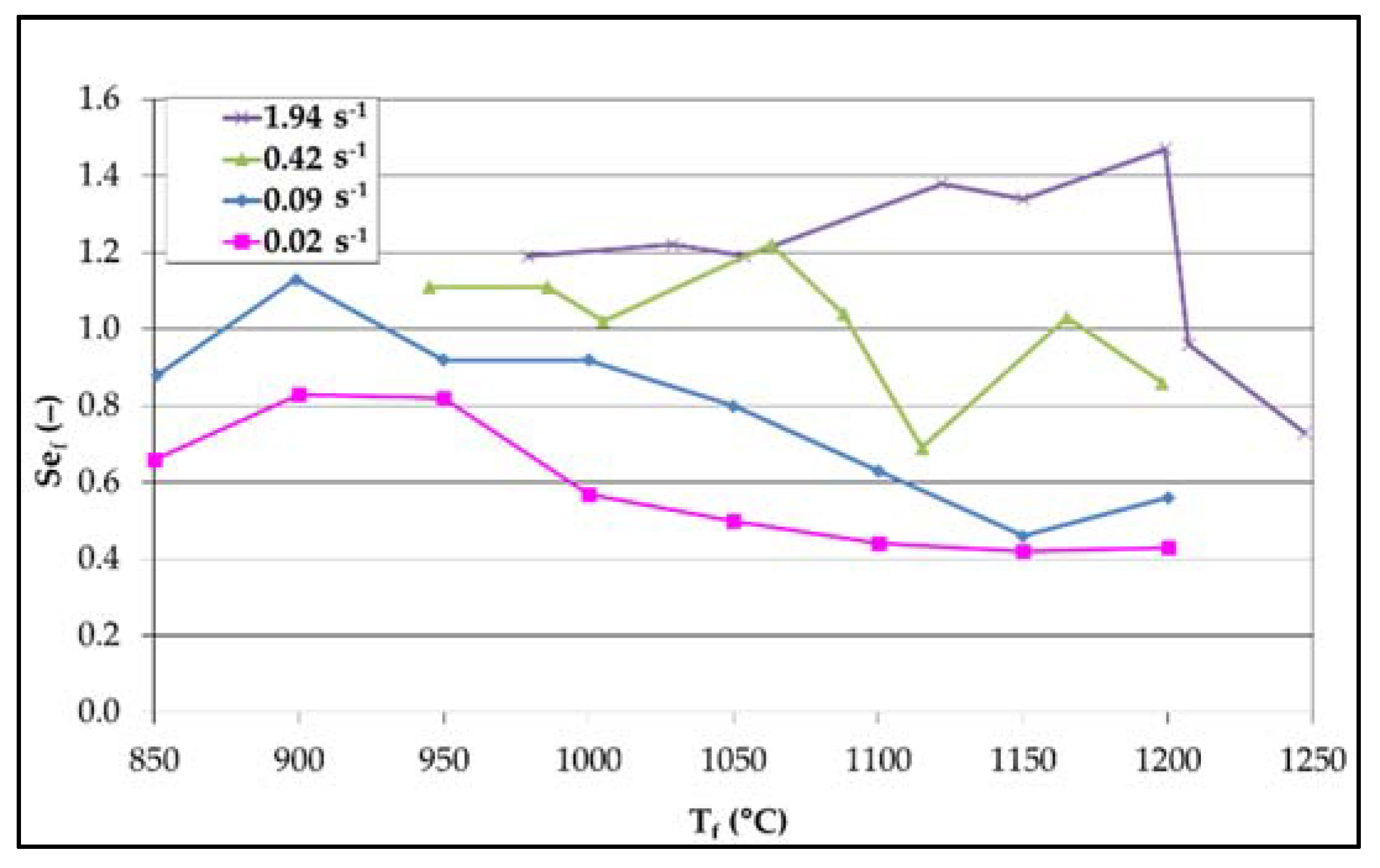
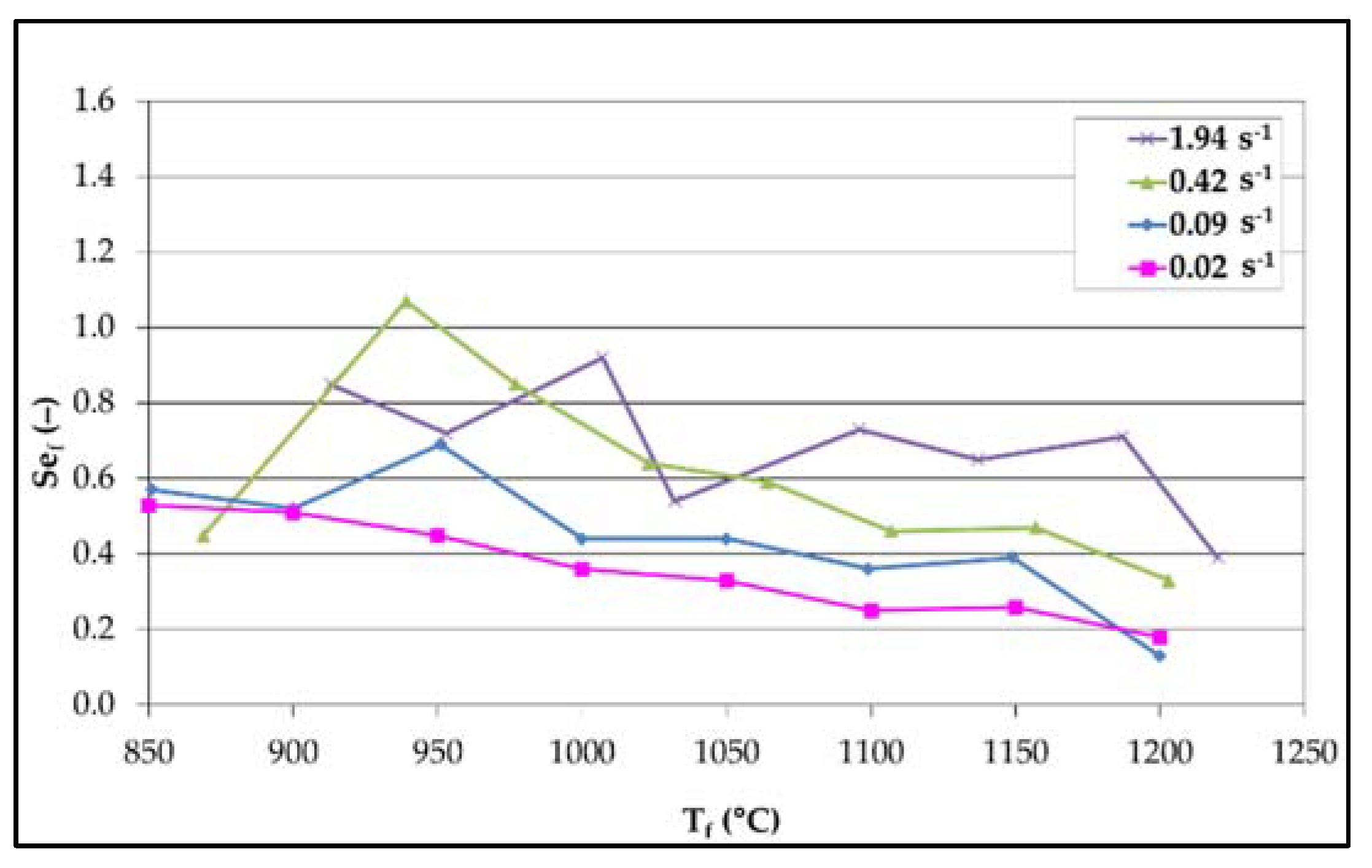


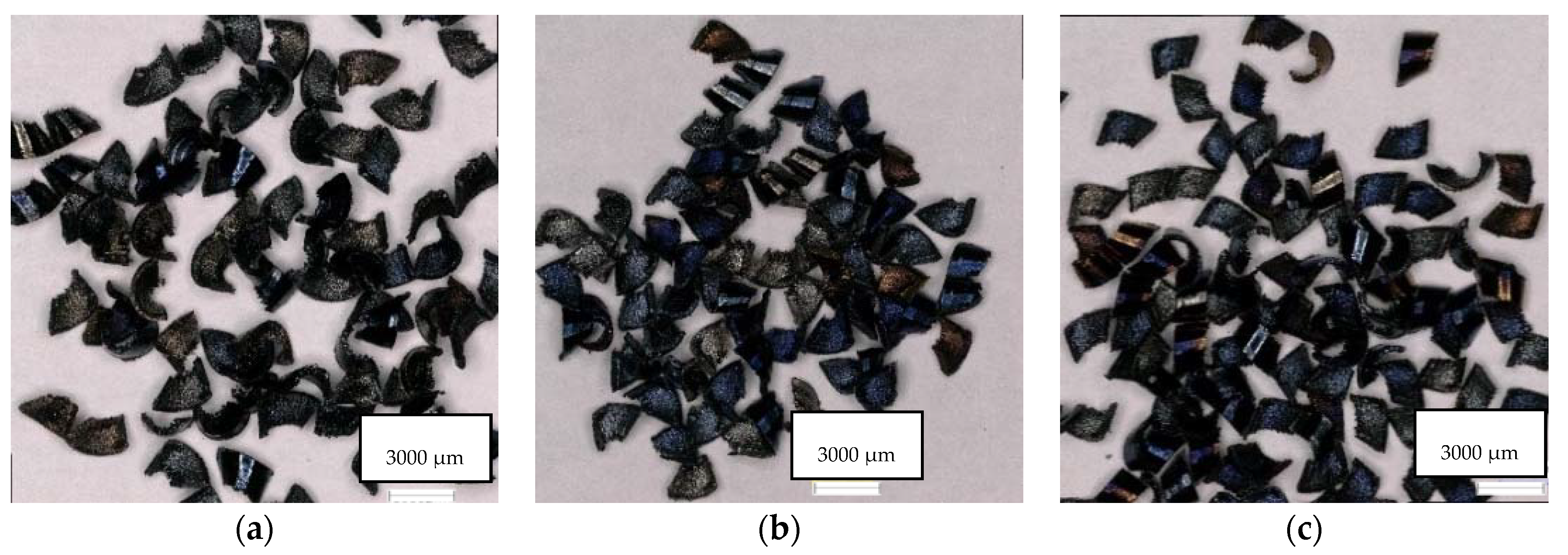

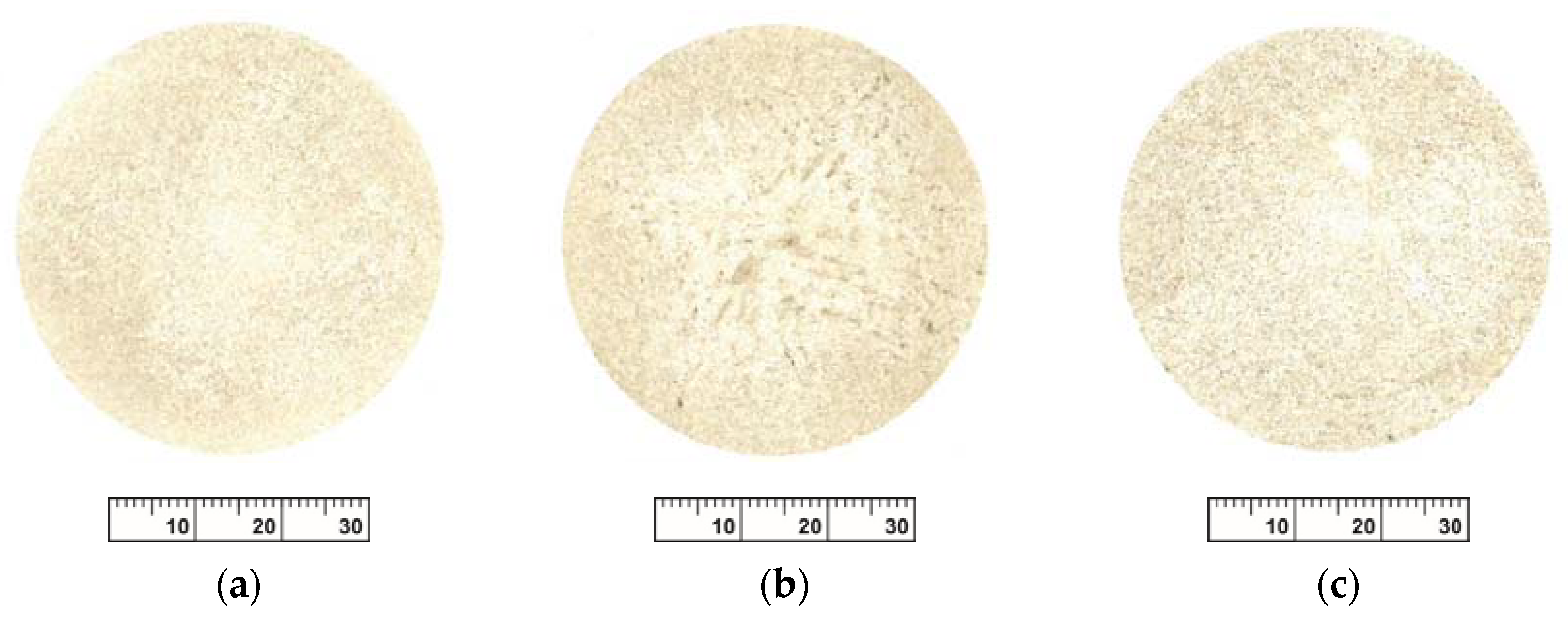
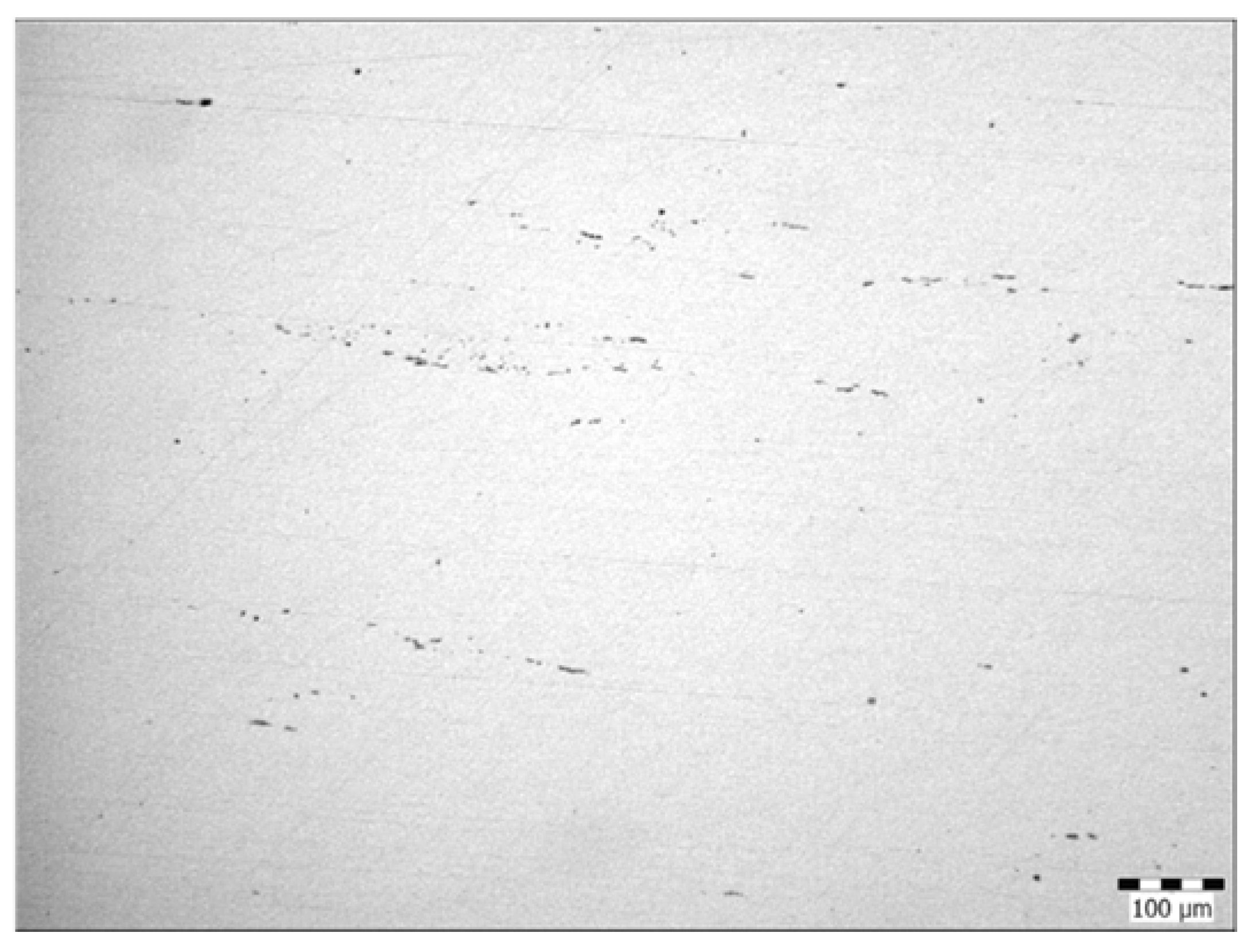

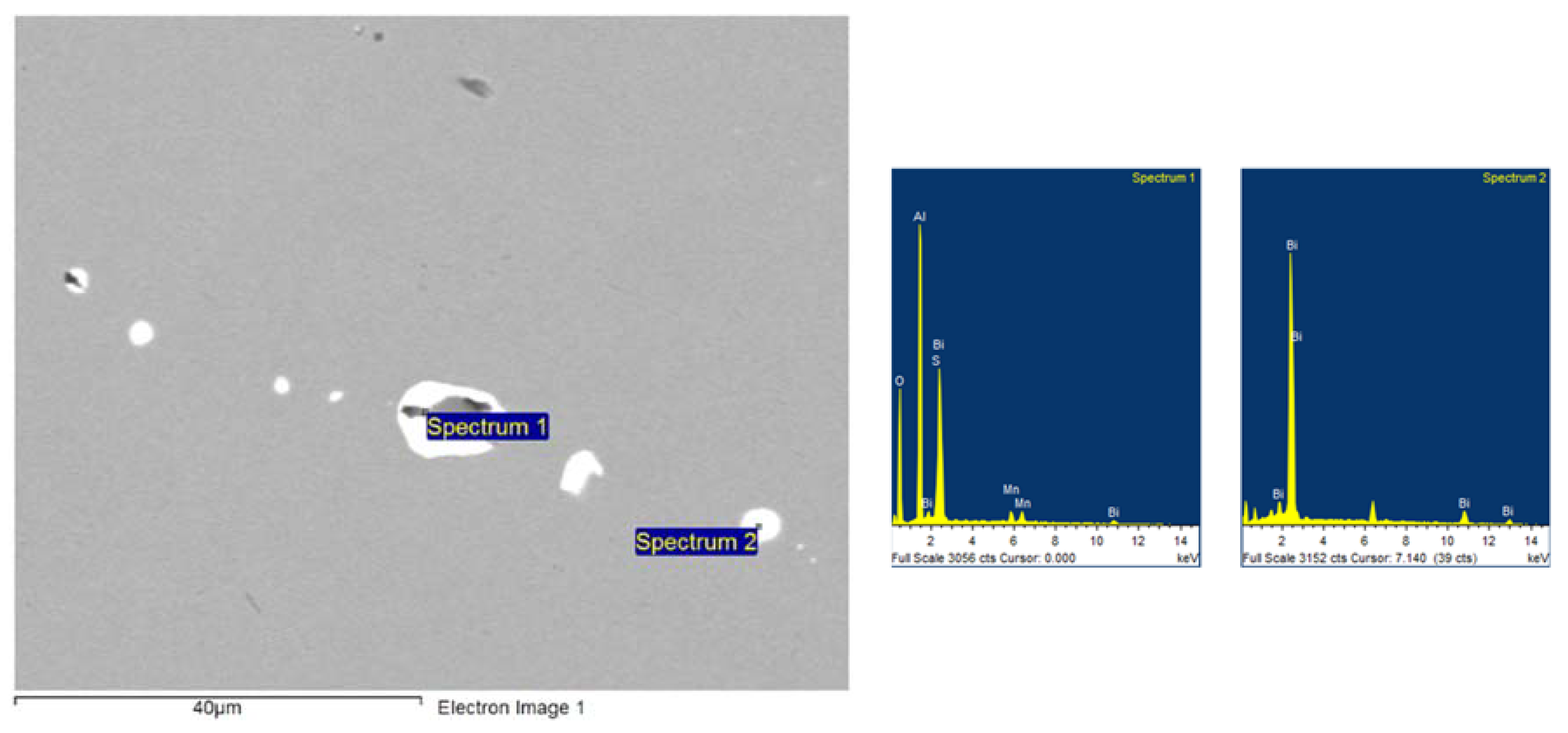
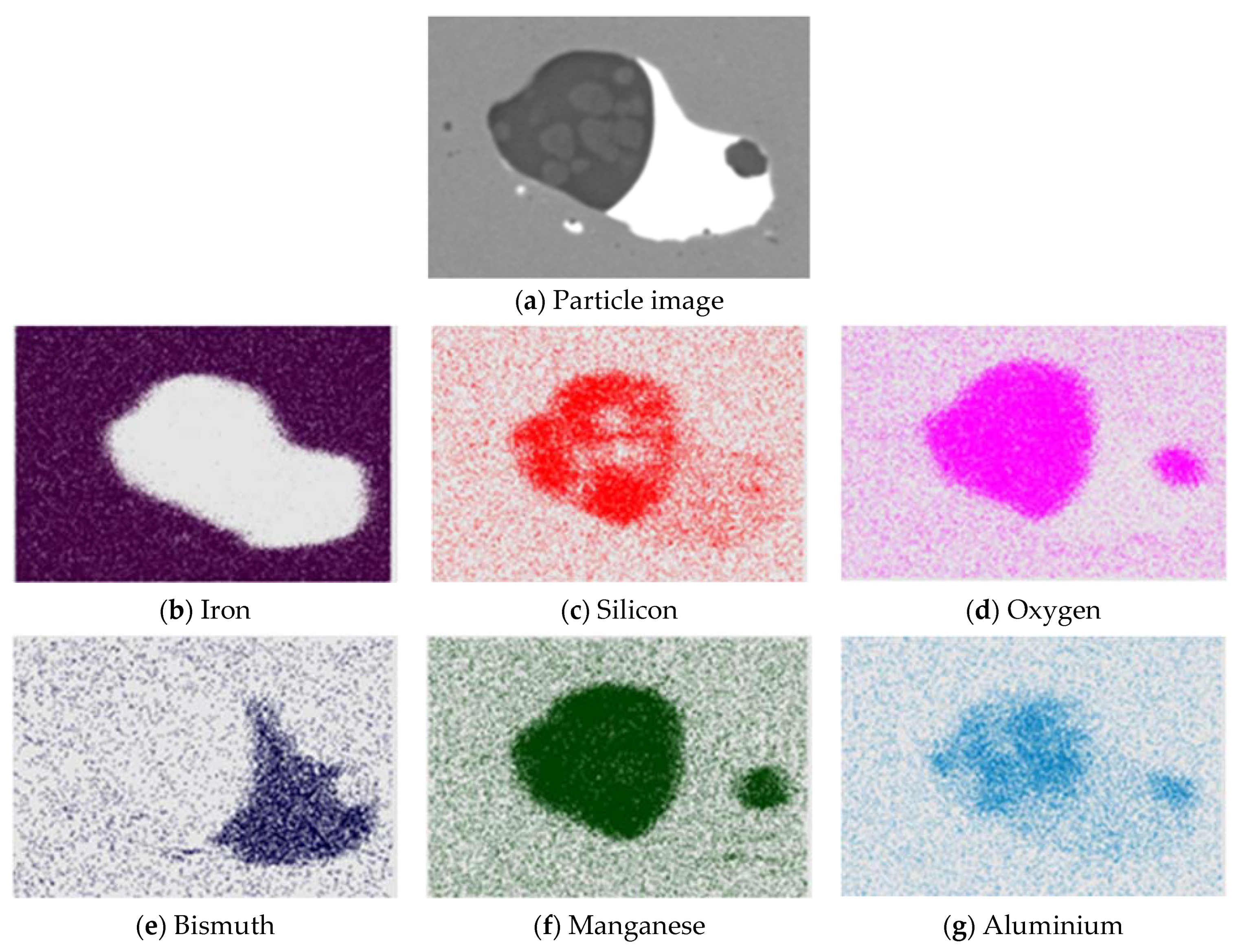



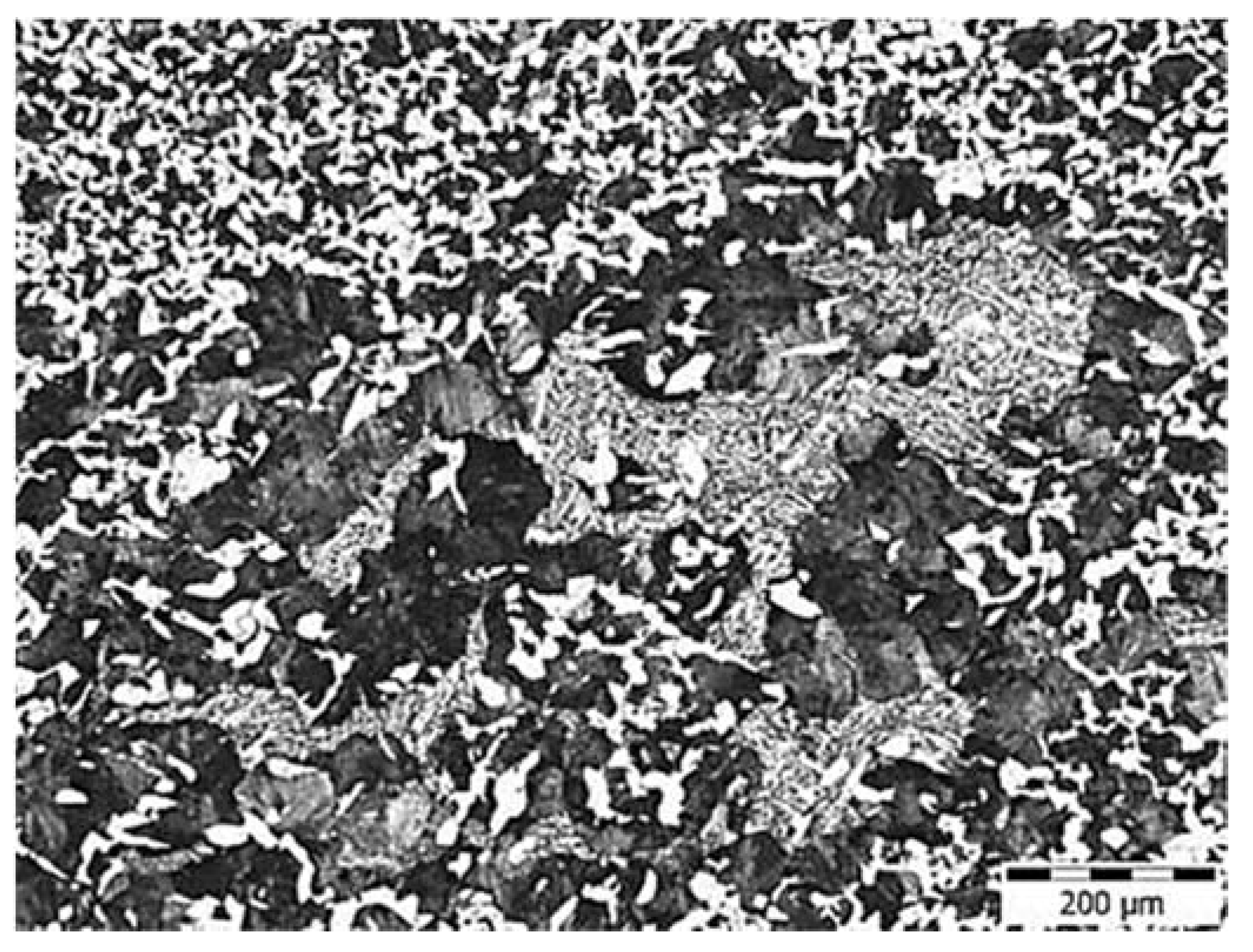
| Heat No. | C | Mn | Si | Al | S | Cu | Ni | Cr | Bi | Mn/S |
|---|---|---|---|---|---|---|---|---|---|---|
| 1 | 0.19 | 1.49 | 0.05 | 0.076 | 0.024 | 0.05 | 0.08 | 1.16 | - | 62.1 |
| 2 | 0.19 | 1.37 | 0.07 | 0.082 | 0.022 | 0.05 | 0.07 | 1.14 | 0.08 | 62.3 |
| 3 | 0.21 | 1.28 | 0.05 | 0.056 | 0.021 | 0.07 | 0.07 | 1.21 | 0.12 | 61.0 |
| CMnCr Steel | Tensile Strength | Yield Stress | Elongation | Reduction of Area | Absorbed Energy | HBW 187.5/2.5 |
|---|---|---|---|---|---|---|
| [MPa] | [MPa] | [%] | [%] | [J] | ||
| Bi-free | 684 | 429 | 15 | 42 | 30 | 222 |
| 0.08 wt. % Bi | 592 | 343 | 20 | 47 | 74 | 178 |
| 0.12 wt. % Bi | 722 | 480 | 13 | 37 | 18 | 247 |
| Elements | O | Al | S | Mn |
|---|---|---|---|---|
| spectrum 1 | - | 3.7 | 35.8 | 60.5 |
| spectrum 3 | - | - | 40.0 | 60.0 |
| spectrum 4 | 57.5 | 42.5 | - | - |
| Elements | O | Al | S | Mn | Bi |
|---|---|---|---|---|---|
| spectrum 1 | 37.6 | 20.0 | 1.8 | 2.3 | 38.3 |
| spectrum 2 | - | - | - | - | 100 |
| Elements | O | Al | S | Mn | Bi |
|---|---|---|---|---|---|
| spectrum 1 | - | - | 40.3 | 59.7 | - |
| spectrum 2 | 50.2 | 45.7 | 0.2 | 3.9 | - |
| spectrum 3 | 9.9 | 1.3 | - | - | 88.8 |
Publisher’s Note: MDPI stays neutral with regard to jurisdictional claims in published maps and institutional affiliations. |
© 2022 by the authors. Licensee MDPI, Basel, Switzerland. This article is an open access article distributed under the terms and conditions of the Creative Commons Attribution (CC BY) license (https://creativecommons.org/licenses/by/4.0/).
Share and Cite
Kurka, V.; Kuboň, Z.; Kander, L.; Jonšta, P.; Kotásek, O. The Effect of Bismuth on Technological and Material Characteristics of Low-Alloyed Automotive Steels with a Good Machinability. Metals 2022, 12, 301. https://doi.org/10.3390/met12020301
Kurka V, Kuboň Z, Kander L, Jonšta P, Kotásek O. The Effect of Bismuth on Technological and Material Characteristics of Low-Alloyed Automotive Steels with a Good Machinability. Metals. 2022; 12(2):301. https://doi.org/10.3390/met12020301
Chicago/Turabian StyleKurka, Vladislav, Zdeněk Kuboň, Ladislav Kander, Petr Jonšta, and Ondřej Kotásek. 2022. "The Effect of Bismuth on Technological and Material Characteristics of Low-Alloyed Automotive Steels with a Good Machinability" Metals 12, no. 2: 301. https://doi.org/10.3390/met12020301
APA StyleKurka, V., Kuboň, Z., Kander, L., Jonšta, P., & Kotásek, O. (2022). The Effect of Bismuth on Technological and Material Characteristics of Low-Alloyed Automotive Steels with a Good Machinability. Metals, 12(2), 301. https://doi.org/10.3390/met12020301






